The Original Dagwood – a guest post from Greg
When the Sandwich Tribunal asked for a volunteer to write about The Dagwood Sandwich, I assumed they meant the kind that the Wikipedia article is about. Appearing frequently in Chic Young (and later Dean Young’s) comic Blondie, and taller than a human head, it’s filled with enough visible fixins to quickly register as Sandwich in the simple visual language of cartooning:
Well sure, heck yeah, sign me up, because that looks like fun!
But then:
Well. Jim jumped on the chance to write about the tall kind of Dagwood, leaving me with the far-less-appealing-sounding Original Dagwood:
Six ingredients (Tongue, Onion, Mustard, Sardine, Beans, and Horseradish), most of which would probably elicit Baby Dumpling’s response (POISON) from most people.
Okay
Fine
Let’s do this
Of those six named ingredients, the only ingredient I had a hard time finding was tongue. However, it turns out there’s one butcher in my city that sells ‘em frozen. I bought the smallest one they had.
DID YOU KNOW: a frozen beef tongue looks like something sloughed off of a character in David Cronenberg’s eXistenZ?
To cook the tongue, I aimed for simplicity, and did the traditional simmering-in-broth thing. I chopped off the end, boiled it for a couple hours, then discarded the tastebud layer and thin-sliced the now-mousebrown meat.
Tasting notes on cooked tongue: a very “deep” flavor of beef, like navy within the blue spectrum, with a slightly bready undertone and a slight hint of blood. Not bad, but definitely the kind of strong and unusual flavor-profile that I’d be more inclined to use as a condiment or component rather than as a standalone entree. So! Perfect for including in a sandwich! WELL PLAYED, BUMSTEAD.
Here are the six ingredients, clockwise from top: black beans, horseradish, yellow mustard, smoked tinned sardine, the thin-sliced tongue, raw sweet onion, and toasted rye bread, which I thought would go well with all the old-school-deli flavors happening in the rest of the shebang.
How was it?
Not so good.
BUT: not the Total Hell Sandwich I’d sort of expected. So… might we then be able to count this as…. A Victory?????
No
Nope
The smoky fishiness of the sardines overwhelmed the rest of the flavors, followed closely by the raw onions. Oddly, compared to the sardine, the tongue flavors were barely noticeable except for contributing a kind of lingering sausagey-gamey aftertaste. The mustard and horseradish were both likewise pretty imperceptible.
If you gave me the option to add anything to the sandwich, I’d put in a vote for something creamy and something green, which I guess would be covered by mayo and lettuce in most club sandwiches. Because of this lack of greenery, I was actually kind of pleased by the raw onions, which came the closest to “vegetable” in the whole thing. Plus, they had a zingy insouciance that bordered on obnoxiousness. I guess I see a lot of myself in those onions.
The beans were an utter failure, on every level.
You know who puts beans in a sandwich?
No, neither do I
They were mealy of texture, with a (frankly rude) tendency to roll around and fall out of the sides, landing with soft little thuds upon the counter, staring up at me like a clowder of orphaned Mameshibas. Further, their semi-spherical nature meant they were totally unintegrated in the sandwich proper; each bite is a gamble between no bean or A Lot Of Bean, and in re the latter: who has ever requested something have “A Lot Of Bean”?
“More bean, please”
“oh this dish is fine but it’s just not beany enough”
“bartender, three fingers of bean, please, and don’t spare the bean”
No
Ridiculous
And yet! I’ve never known myself to be anti-bean before their disappointing presence in this sandwich. In fact, in Mexican sandwichlikes (tacos, burritos, the various bastard appropriative sandwichlings peddled by Taco Bell), I can’t get enough of refried beans! It’s a marvelous paste that not only tastes great, but also does the exact opposite of these beans’ uncooperative rolling around; refried beans actually help everything else cohere.
So as I stood over my sink, chewing these awful naughty beans, I began to think about how I might improve the Dagwood. And I formulated a plan for:
The Original Dagwood 2.0: A Revised Attempt
What to do? Let’s list our desires:
- HELP THE TEXTURE
The first version was both too mushy and too dry, like chewing on a men’s dress sock. We need moisture or lipids, and we need crunch. And when I think about crunchiness and lipids, my fancy turns lightly to thoughts of deep-frying. So maybe something in there could be fried? Maybe A LOT could be fried? At the very least, let’s pan-crisp the outside like you would a grilled cheese. And speaking of the outside:
- HELP THE BREAD
In addition to grilling the whole thing, maybe we can switch out the rye. I mean, I love rye, but the rye’s caraway seeds were pretty noticeable compared to the lack of taste from the mustard, horseradish, and tongue. Back to basics, then; we’ll approach the bread as a gentle background note, using a simple white rustic bread.
- HELP THE SARDINES
I like sardines! But not so much that I want to taste them to the exclusion of all else. So let’s pull back on the flavor a bit and incorporate them into a crisp deepfried fishcake. That would cover my deep-frying idea, and help pull the sardinian flavor into more of a support role within the other traditional elements of a fried fishcake: breadcrumbs, egg, and spices.
- HELP THE TONGUE
Not flavorful enough, and an uninteresting texture. Thankfully, Mexico solved these problems long ago by frying up tongue for Tacos De Lengua. Fried tongue is crisp and roasty and wonderful! So after we simmer the meat long enough to be able to peel the tastebuds off of it, let’s try confiting the tongue in hot lard, then re-frying it until it’s crisp. Between the bread, the fishcake, and the frying of the tongue, that’s three crispy fried components so far, so that should better the texture.
- HELP THE ONIONS
While I like the rawness of the onion, I feel like the sweetness of a caramelized onion might play better with the roastier flavors of lengua. So let’s do both: some onions caramelized and served in the sandwich proper, some onions raw but incorporated into the fishcake.
- HELP THE CONDIMENTS
Mustard-wise: I plan to swap out yellow for a slightly-mellower stone-ground brown, and I’ll use more of it. Horseradish-wise: one of my favorite all-time condiments is a recipe from the 1997 edition of Joy Of Cooking (appearing in no other editions, weirdly). It’s a horseradish cream sauce that I usually make by whipping the cream and adding some chopped parsley. Which would neatly fulfill my desire for both creaminess and greenery!
- HELP THE BEANS
No more of these unadorned troublesome beans; we will make a bean dip that will be good enough to stand on its own. A bean spread that will bind rather than destabilize. A bean schmear that will unite rather than divide. A beans we can be proud of.
WITH THESE PLANS IN HAND, LET’S GO TO SOME RECIPES!
BREAD RESULTS: GOOD, VERY TASTY, SIMPLE GOOD BREAD, GOOD HONEST BREAD. LET’S MOVE ON
FISHCAKE RESULTS: CRISPY, WONDERFUL, FISH FLAVOR PRESENT BUT NOT OVERPOWERING, THE GARLIC IS DOING WONDERS HERE, THE MOSTLY-STILL RAW ONIONS ARE JUST LOVELY. MADE ENOUGH FOR TWO FISHCAKES BUT ONLY USED ONE. AH WELL
TONGUE RESULTS: I AM TRYING REALLY HARD TO NOT TURN THAT PHRASE INTO A VULGAR JOKE BUT YES THE TONGUE IS MUCH NICER WHEN CRISPED UP
HORSERADISH CREAM SAUCE RESULTS: WE KNEW THIS WOULD BE GOOD TBH
BEAN SPREAD RESULTS: I WOULD ACTUALLY EAT THIS, LIKE, WITH CHIPS. I LIKE THIS A BUNCH. GOOD. WONDERFUL
Assembling the sandwich:
And how did Original Dagwood 2.0 taste?
Fairly great, actually! Between all the added frying and fat this time around, it was much greasier, but I have a pretty high tolerance for grease, so that was nothing but a plus in my book.
Texture-wise: Between the added moisture and oil, the fresh squishiness of the bread, and the nearly-falling apart texture of the fishcake, the whole thing had a much more “bread pudding”-like texture than the first version (think of the soft, immediately-yielding mouthfeel of a White Castle slider). But because of the crisp outside of the fishcake, the super-crisp texture of the tongue confit, and the outer grilled brownness of the bread, there was still plenty of crunch, which the first version had been missing.
The fish flavor was still present in the sardine fishcake, but in a much softer and more palatable way, the same way you might pick up a wee bit of ocean-creature in an anchovy-heavy puttanesca. Just enough to give a hint that maybe the sandwich liked to go wading in tidepools on its vacations.
The tongue flavor here, being deeply-browned and not overpowered by the fish, was lovely. Something about it tasted familiar, but I couldn’t quite place what I was thinking of.
I gave a bite of this sandwich to my wife, who pronounced it “pretty good”, chewed for a moment, and then said, “it tastes like haggis.” Which: THAT’s the familiar flavor I couldn’t place! The sausagey-bloody notes of the tongue, mixed with the grain flavors of the bread, the onions, and the various spices throughout, did indeed taste a lot like the haggis I make each year for Burns Night. That’s a swell attribute in my book, although I suppose if you hate haggis, I am not exactly endearing the sandwich to you right now.
So: I think this version is about as close as I can get to something I might actually choose to eat. To be honest, if you put a full sandwich menu in front of me, I’d be way more likely to pick a BLT, or Cubano, or even a grilled cheese over this Dagwood. But I could potentially see myself, on some cold and wet winter night, craving this hearty monstrosity with a big mug of warm dark beer. I am calling this version a success.
Oh, and one more note: while the grease was a nice common denominator for marrying all the flavors, I’d say at least an equal amount of heavy lifting was done by the garlic; it was present in the confit’s lard, the fishcake, and the bean spread. It’s a flavor that goes well with just about everything in the sandwich, and frankly, I’m kinda surprised Chic Young didn’t include it in the original strip, given its fame for overpowering odoriferousness.
Is it therefore so present that it should be counted as a new ingredient? Is it possible that it exceeds its status as a mere flavoring for the other six ingredients, and has become a full Seventh Ingredient in its own right? By adding it, have I cheated?
Well maybe
maybe sure but what are you gonna do, call the cops on me?
call em, see if they come, see if they arrest me because I cheated at sandwich
go for it
i’m not scared



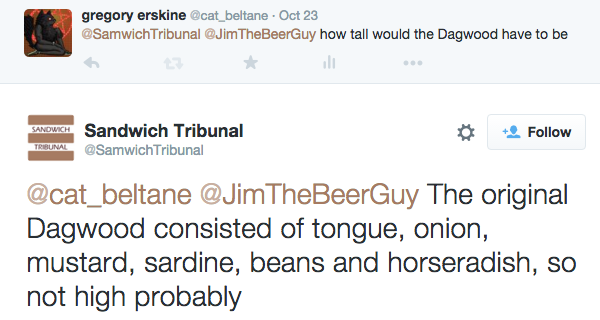


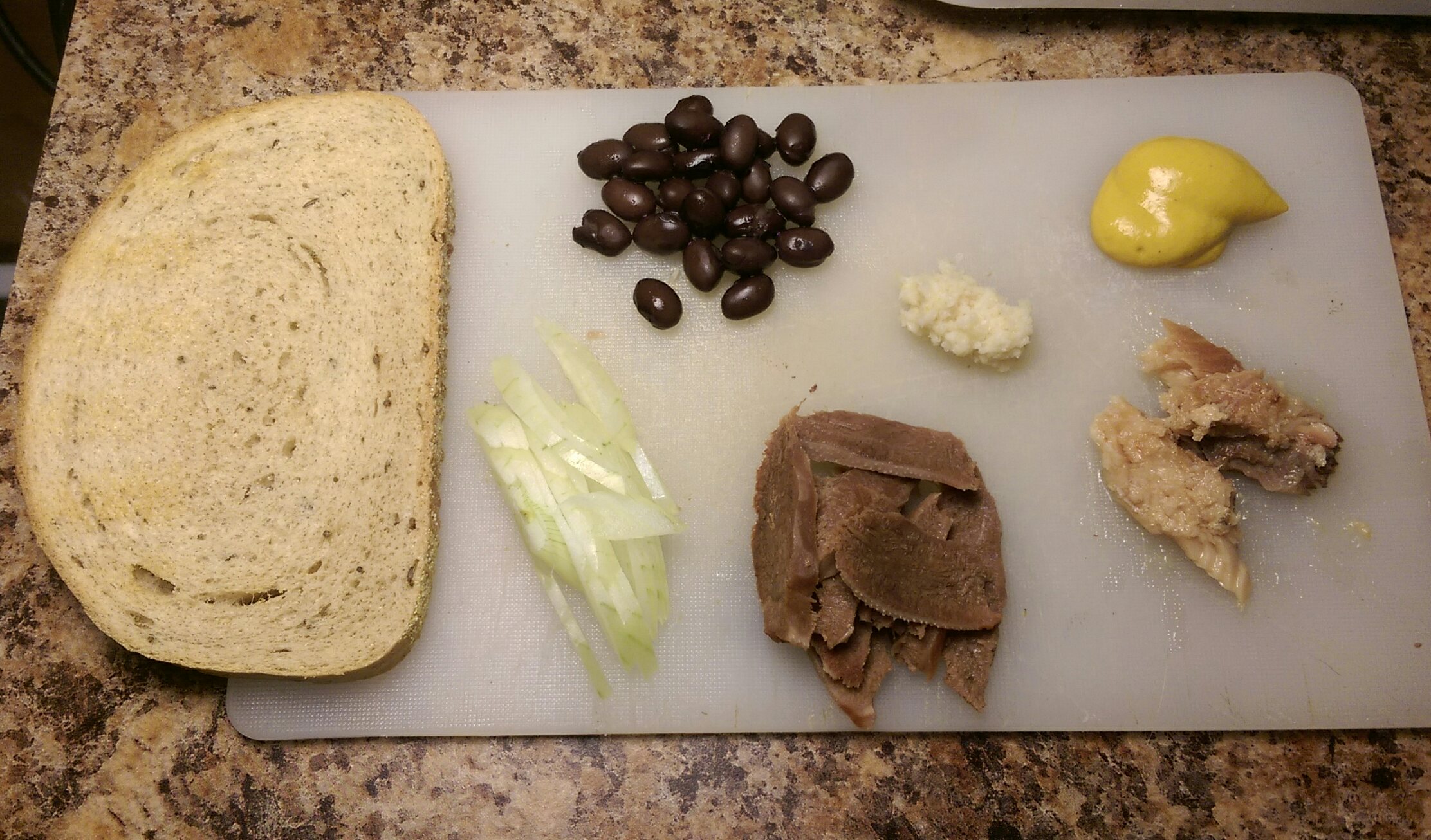
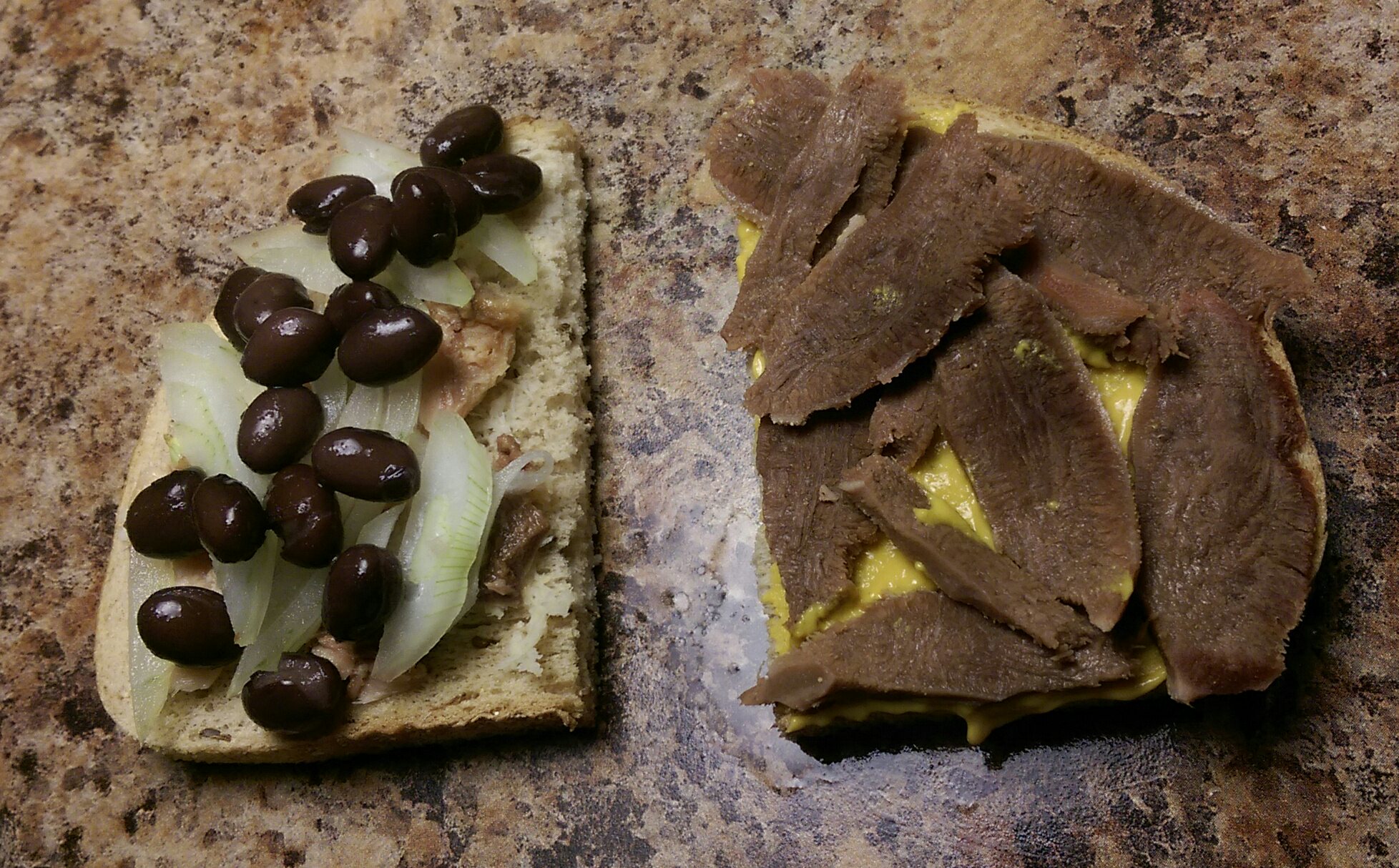
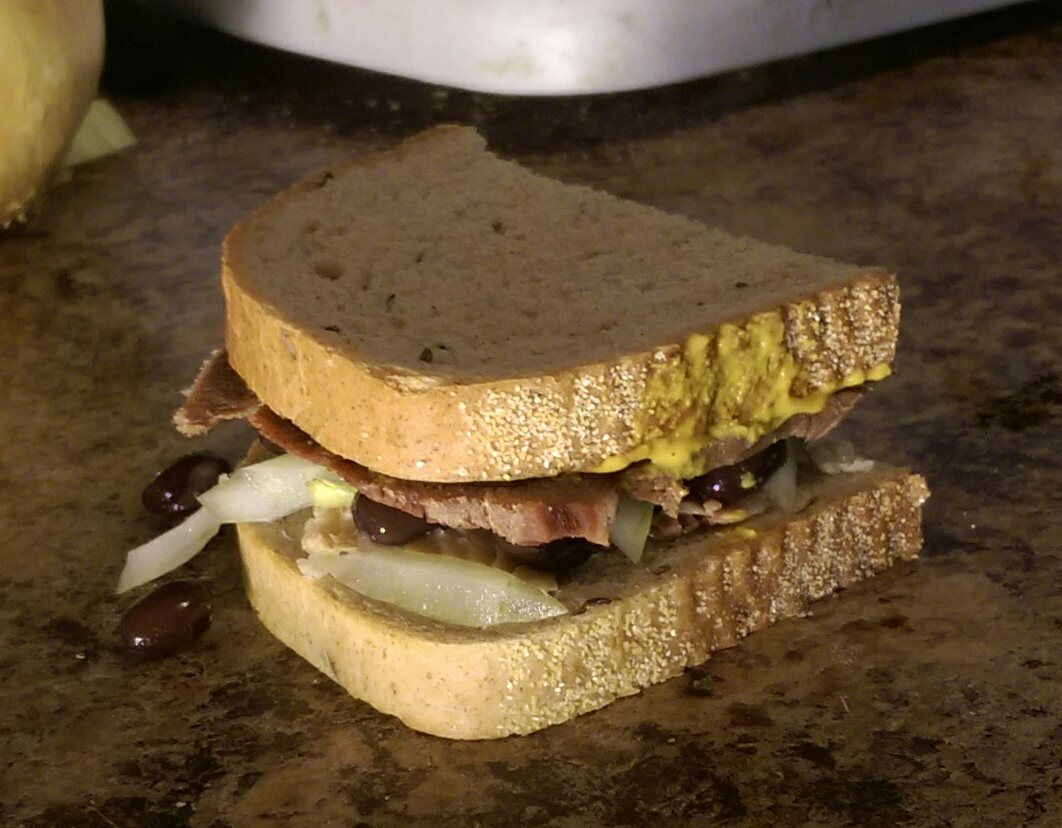

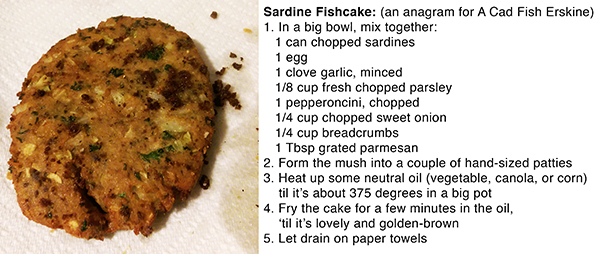
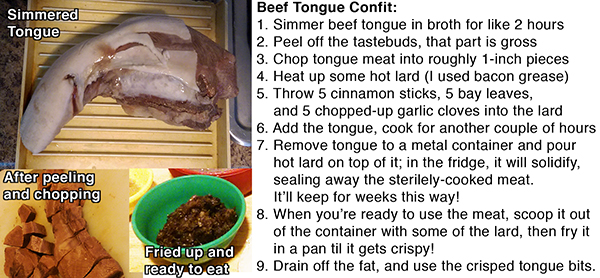
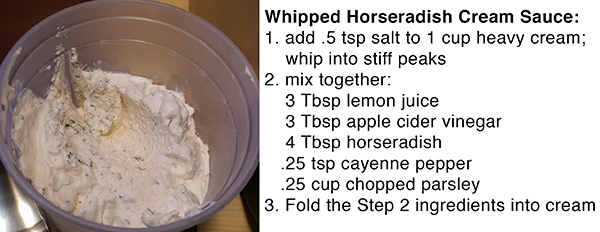
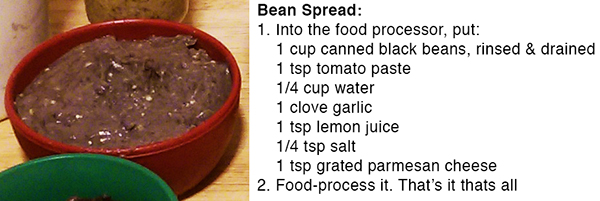

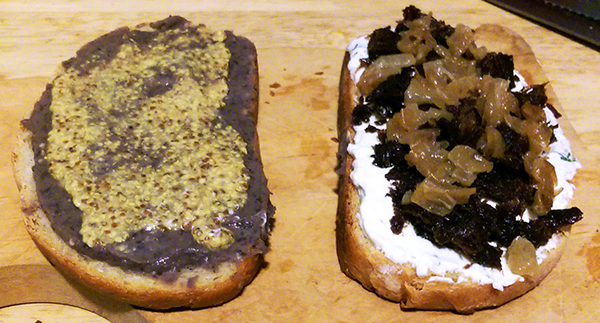
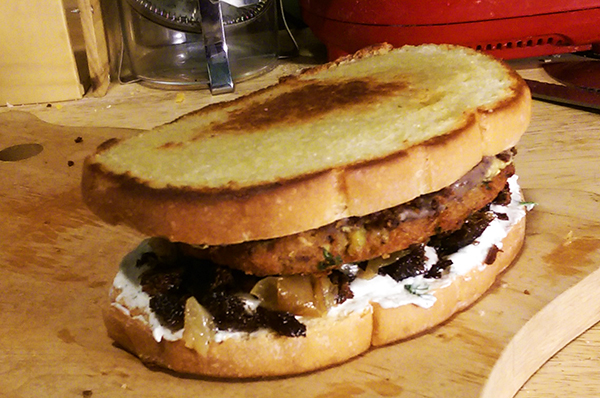
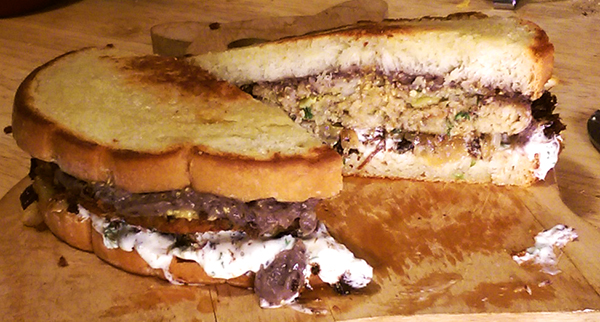

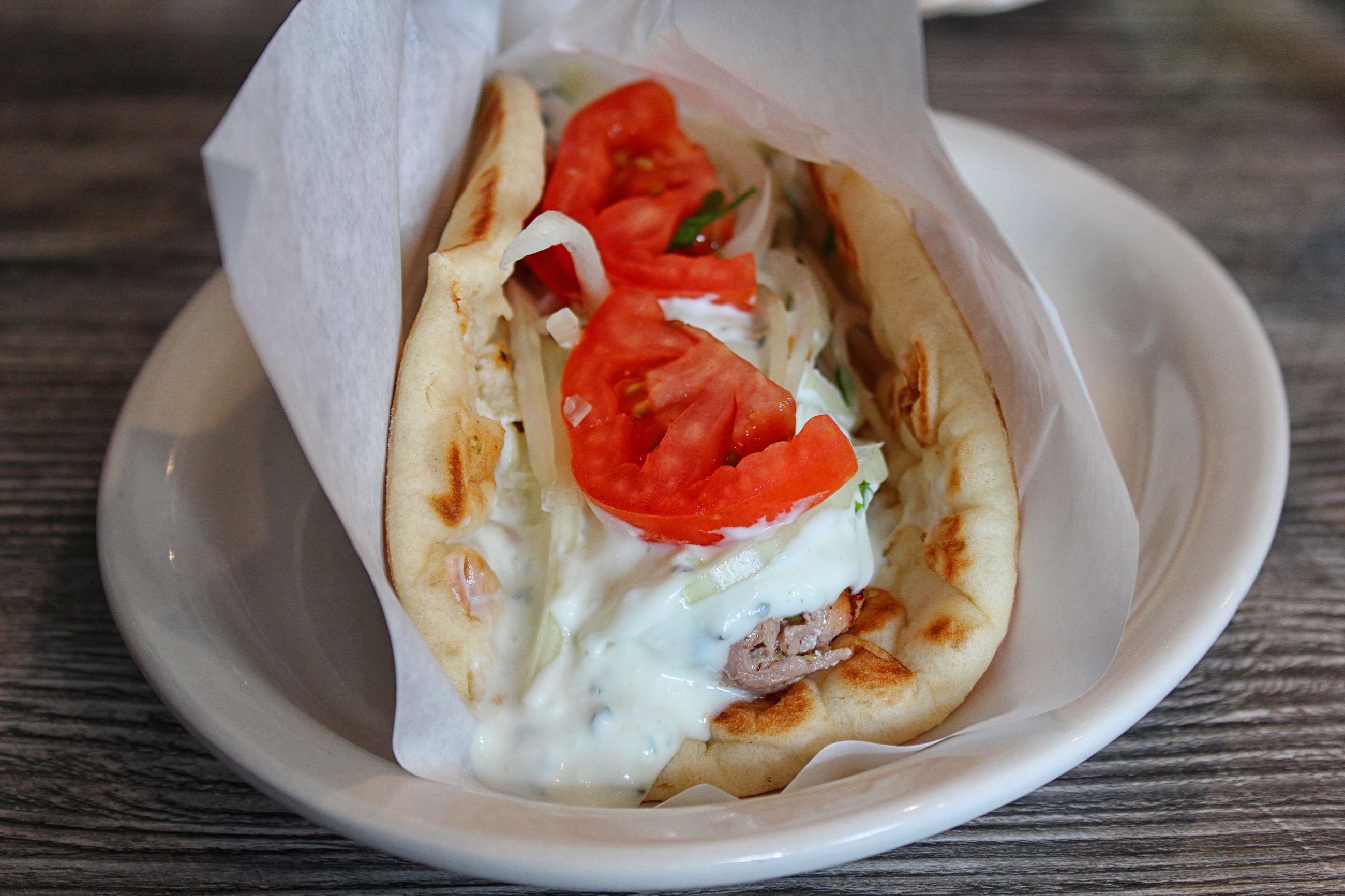
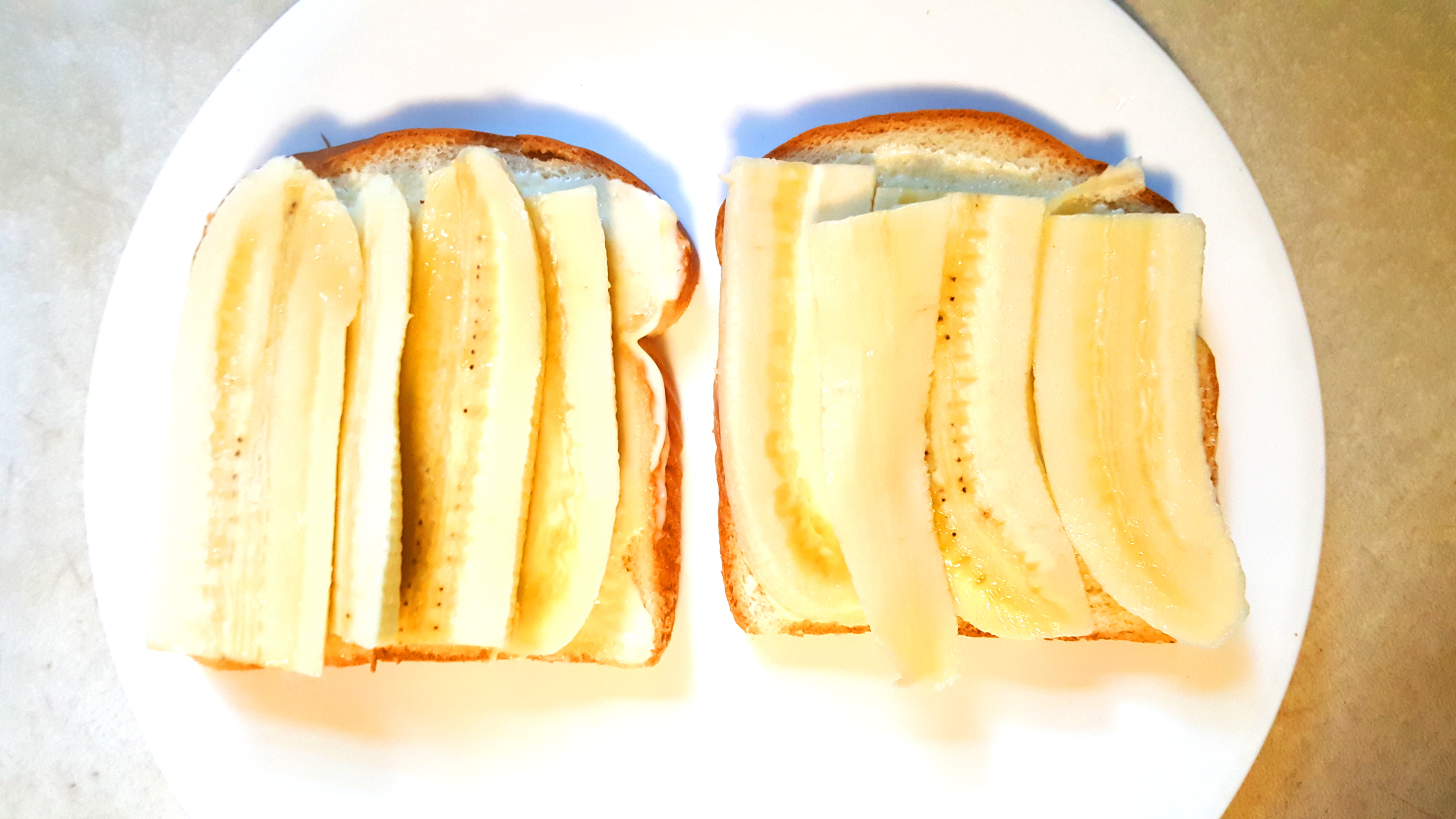






What about using fresh sardines lightly fried? They’re a bit of a pain to debone (they’re bigger than the kind that come in cans, so the bones are bigger, too) but might be worth it for a milder taste. Another option would be to substitute canned anchovies, which are a bit milder than sardines. Or, if you were using smoked sardines (which it sounds like you were) maybe skip the smokey kind and go for regular, or sardines in tomato sauce, which would add a little tomato flavor.
Instead of cooking the tongue yourself, why not get buy it like cold-cuts? I think that is what is in the original sandwich.